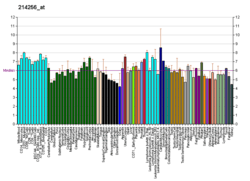ATP10A
Probable phospholipid-transporting ATPase VA also known as ATPase class V type 10A (ATP10A) or aminophospholipid translocase VA is an enzyme that in humans is encoded by the ATP10A gene.[5][6][7]
Function
The protein encoded by this gene belongs to the family of P-type cation transport ATPases, and to the subfamily of aminophospholipid-transporting ATPases. The aminophospholipid translocases transport phosphatidylserine and phosphatidylethanolamine from one side of a bilayer to another. This gene is maternally expressed. It maps within the most common interval of deletion responsible for Angelman syndrome, also known as 'happy puppet syndrome'.[7]
gollark: Active steps to worsen it because it brings you some bizarre "gain" evenm
gollark: You're taking active steps to worsen it. This is generally considered sabotage.
gollark: It is not better because you're """funny""" about it.
gollark: I consider this bad. I don't think you care, but you also don't have the right to stop it being fixed now.
gollark: And yet you try and hold it in reserve so you can feel smug and do stuff with it.
See also
References
- GRCh38: Ensembl release 89: ENSG00000206190 - Ensembl, May 2017
- GRCm38: Ensembl release 89: ENSMUSG00000025324 - Ensembl, May 2017
- "Human PubMed Reference:". National Center for Biotechnology Information, U.S. National Library of Medicine.
- "Mouse PubMed Reference:". National Center for Biotechnology Information, U.S. National Library of Medicine.
- Halleck MS, Lawler JF JR, Blackshaw S, Gao L, Nagarajan P, Hacker C, Pyle S, Newman JT, Nakanishi Y, Ando H, Weinstock D, Williamson P, Schlegel RA (Oct 2000). "Differential expression of putative transbilayer amphipath transporters". Physiol Genomics. 1 (3): 139–50. doi:10.1152/physiolgenomics.1999.1.3.139. PMID 11015572.
- Nagase T, Ishikawa K, Miyajima N, Tanaka A, Kotani H, Nomura N, Ohara O (Aug 1998). "Prediction of the coding sequences of unidentified human genes. IX. The complete sequences of 100 new cDNA clones from brain which can code for large proteins in vitro". DNA Res. 5 (1): 31–9. doi:10.1093/dnares/5.1.31. PMID 9628581.
- "Entrez Gene: ATP10A ATPase, Class V, type 10A".
External links
- Human ATP10A genome location and ATP10A gene details page in the UCSC Genome Browser.
Further reading
- Kato C, Tochigi M, Ohashi J, et al. (2008). "Association study of the 15q11-q13 maternal expression domain in Japanese autistic patients". American Journal of Medical Genetics. 147B (7): 1008–12. doi:10.1002/ajmg.b.30690. PMID 18186074.
- Gerhard DS, Wagner L, Feingold EA, et al. (2004). "The Status, Quality, and Expansion of the NIH Full-Length cDNA Project: The Mammalian Gene Collection (MGC)". Genome Res. 14 (10B): 2121–7. doi:10.1101/gr.2596504. PMC 528928. PMID 15489334.
- Strausberg RL, Feingold EA, Grouse LH, et al. (2003). "Generation and initial analysis of more than 15,000 full-length human and mouse cDNA sequences". Proceedings of the National Academy of Sciences of the United States of America. 99 (26): 16899–903. doi:10.1073/pnas.242603899. PMC 139241. PMID 12477932.
- Dhar M, Hauser L, Johnson D (2003). "An aminophospholipid translocase associated with body fat and type 2 diabetes phenotypes". Obes. Res. 10 (7): 695–702. doi:10.1038/oby.2002.94. PMID 12105293.
- Herzing LB, Kim SJ, Cook EH, Ledbetter DH (2001). "The Human Aminophospholipid-Transporting ATPase Gene ATP10C Maps Adjacent to UBE3A and Exhibits Similar Imprinted Expression". Am. J. Hum. Genet. 68 (6): 1501–5. doi:10.1086/320616. PMC 1226137. PMID 11353404.
- Meguro M, Kashiwagi A, Mitsuya K, et al. (2001). "A novel maternally expressed gene, ATP10C, encodes a putative aminophospholipid translocase associated with Angelman syndrome". Nat. Genet. 28 (1): 19–20. doi:10.1038/88209. PMID 11326269.
- Gillessen-Kaesbach G, Demuth S, Thiele H, et al. (1999). "A previously unrecognised phenotype characterised by obesity, muscular hypotonia, and ability to speak in patients with Angelman syndrome caused by an imprinting defect". European Journal of Human Genetics. 7 (6): 638–44. doi:10.1038/sj.ejhg.5200362. PMID 10482951.
This article is issued from Wikipedia. The text is licensed under Creative Commons - Attribution - Sharealike. Additional terms may apply for the media files.





